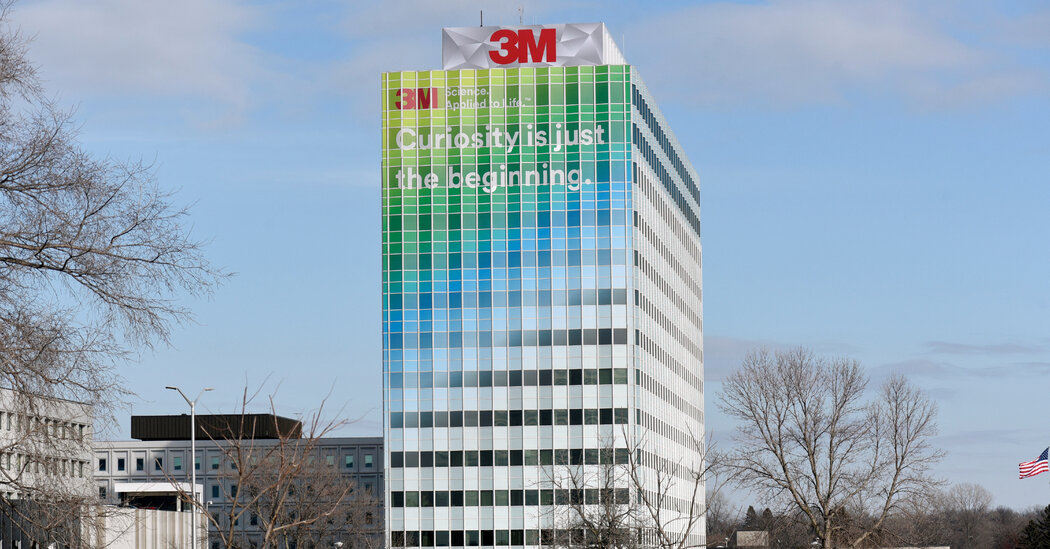The chemical and manufacturing giant 3M reached a $10.3 billion settlement on Thursday with US cities and towns over their claims that the company has contaminated drinking water with so-called forever chemicals used in everything from firefighting foams to nonstick coatings.
Under the sweeping settlement, 3M said it would pay out the money over 13 years to cities, counties and others across the country to test and clean up perfluoroalkyl and polyfluoroalkyl substances, known as PFAS, in public water supplies.
3M, which is facing approximately 4,000 state and municipal lawsuits for PFAS contamination, has not admitted any liability. The company said the settlement covered the remediation of water suppliers who could detect the chemical “at any level or in the future.”
In a statement, Mike Roman, 3M’s chairman and CEO, called the agreement “an important step forward for 3M” and said it builds on “our announcement that we will end all PFAS production by the end of 2025.”
The settlement, which requires court approval, would end legal claims, including a test case filed by the city of Stuart, Fla., which was scheduled for trial in a federal judge on June 5. Mike Mortell, Stuart’s city manager, said the community was “grateful” that the settlement had been reached.
The deal followed a similar agreement with Chemours, DuPont and Corteva, who agreed on June 2 to deposit $1.19 billion into a fund that will be used to remove PFAS from public drinking water systems.
PFAS have been linked to liver damage, developmental problems, impaired immune function and cancer, and are forever referred to as chemicals because they remain so persistent in the human body and the environment. They have also been found in hundreds of wildlife species around the world.
The synthetic chemicals are so ubiquitous that nearly all Americans, including newborns, carry PFAS in their bloodstream, and as many as 200 million Americans are exposed to PFAS through their tap water, according to a 2020 peer-reviewed study.
Hundreds of communities across the country have sued 3M and other PFAS manufacturers, alleging that their soil and water had been contaminated by the chemicals, which are also used in food packaging and a wide variety of other products to make them resistant to heat, water, oil and corrosion.
In one such lawsuit, the city of Stuart sued 3M and several other companies in federal court, alleging that its water supply had been contaminated by firefighting foam containing PFAS — which has been used for decades in training exercises by the city’s fire department.
But as 3M and the plaintiffs approached a settlement, they asked a federal judge in South Carolina to postpone the trial so they could try to strike a deal instead. The judge gave the parties a maximum of 21 days to reach an agreement.
While the settlement will help major cities and towns tackle PFAS water pollution, local taxpayers will still pay a large share of the cleanup bills, Mr Mortell, who was formerly Stuart’s city attorney, said in an earlier statement. interview.
He noted that in 2016, Stuart closed and replaced wells that were polluting the local water supply but still incurring cleanup costs. The city had estimated damage and cleanup costs for Stuart alone at $100 million to $120 million, he said.
“I don’t think we’ll ever get close to that much just to town, so I don’t think we can get whole,” Mr Mortell said.
Brunswick County, NC, spent nearly $1 billion after extensive PFAS contamination was found in the Cape Fear watershed, and still spent about $2.9 million a year in spending, a 2021 study found. , California, has also estimated that the infrastructure needed to reduce levels of PFAS in its drinking water could cost $1 billion.
In addition to being approved by the South Carolina federal judge, which oversees so-called multidistrict litigation, the settlement must be signed by the plaintiffs. The judge must also approve the reasonableness of any fee requests from the dozens of law firms representing plaintiffs in the lawsuit. It’s not uncommon for plaintiffs’ attorneys to take home as much as 30 percent of a settlement.
3M said in a statement it would continue to address other PFAS lawsuits “by defending itself in court or through negotiated resolutions, as the case may be.”
Researchers have attempted to estimate the health damage of PFAS in the United States in dollars: A 2022 study found that the cost of treating illnesses attributable to PFAS exposure is as much as $62.6 billion. And when the country proposed a rule last year to strengthen drinking water standards for PFAS, the Environmental Protection Agency calculated an annual benefit of $533 million in improved cardiovascular health, $300 million in reduced renal cell carcinoma and $178 million in the reduction of low birth rates. – weight births in the United States.
Analysts at Morningstar, a research firm, estimate that 3M’s total liabilities related to PFAS could reach as much as $30 billion when state, foreign and personal injury claims are taken into account.
PFAS cleanup efforts have gained urgency since the EPA said the government would for the first time propose regulations to require near-zero levels of the chemicals in drinking water after finding that almost no amount of exposure is safe.
Some industry groups said the Biden administration had created an impossible standard that would cost manufacturers and municipal water agencies billions of dollars. Industries should stop releasing chemicals into waterways, and water companies should test for and remove the PFAS chemicals. Communities with limited resources will be hit hardest by the new rule, they warned.
Matt Goldstein reporting contributed.

